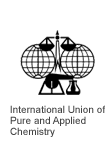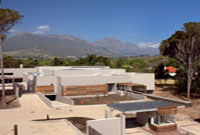 |
 World Forum on Advanced Materials 7-11 April 2014, STIAS Research Centre, Stellenbosch, South Africa |
 |
 |
 |
| Information |
- Welcome to Stellenbosch
- General
- Climate
Stellenbosch is a town in the Western Cape province of South Africa, situated 50 km from Cape Town, along the banks of the Eerste River. It is the second oldest European settlement in the province, after Cape Town. The town became known as the City of Oaks, or Eikestad in Afrikaans and Dutch, due to the large number of oak trees that were planted by its founder, Simon van der Stel, to grace the streets and homesteads.
The town, ideally situated in a magnificent mountain valley, boasts a mild Mediterranean climate and is the ideal destination from which to explore the Winelands, Cape Town, the Cape Peninsula and the many tourist attractions that the area has to offer.
Stellenbosch has its own municipality (incorporating the neighbouring towns of Pniel and Franschhoek), adjoning the greater metro of the city of Cape Town. The town is home to Stellenbosch University. Technopark is a modern science park situated on the southern side of the town near the Stellenbosch golf course.
Currency
The rand (sign: R; code: ZAR) is the currency of South Africa. At present (April 2013), exchange rate is about R8.99 (USD1). Guest houses, hotels, restaurants and shops generally may accept major international credit cards including Visa, American Express, Diners Club and Master Card.
The current exchange rate can be confirmed at: Currency Converter
Electricity
The South African electricity supply is 220/230 volts AC 50 HZ.
Most plugs are 15 amp 3-prong or 5 amp 2-prong, with round pins. If an adaptor is called for, consider bringing one with you, although they can be purchased locally.
US-made appliances may need a transformer.
Most hotel rooms have 110 volt outlets for electric shavers and appliances.
Visa Requirements
Should you require a VISA letter for obtaining your visa, please first register for the conference and pay your conference fee. Please complete the POLYCHAR Form for Visa application (below) and e-mail to: aef2@sun.ac.za, whereafter you will receive your VISA letter.
Download POLYCHAR Form for Visa.doc
To determine whether you need a visa to visit South Africa, please visit the South African Department of Home Affairs website which provides detailed information on South Africa's visa requirements. Department of Home Affairs
The website gives particulars about which nationals require visas and which are exempt. Enquiries regarding South Africa visa information can also be obtained from South African missions in your home country, or the mission nearest to you.
For nationals of countries requiring visas, applications for visas must be made ahead of your departure as visas are not issued on arrival. The visas must be affixed in your passport and shown to immigration officials on landing. Applications must be made through South African diplomatic or consular representatives.
To apply for a visa you will be required to furnish particular documentation to meet South Africa's visa requirements. These include:
A passport valid for no less than 30 days after the expiry of the intended visit, and at least 1 unused page for entry/departure endorsements (sometimes referred to as the visa page).
Payment of the prescribed fee, if applicable.
A vaccination certificate, if required. (Travel through the yellow fever belts of Africa and South America requires inoculation.)
Statement and/or documentation confirming the purpose and duration of your visit.
Two identity photographs (guidelines on website).
Proof of financial means in the form of bank statements; salary advices; undertakings by your hosts in South Africa; bursaries; medical cover; or cash available, including credit cards or travellers' cheques.
If travelling by air, a return or onward ticket; or proof of sufficient funds; or a cash deposit of equivalent value to an air ticket must be lodged.
Take care to request the correct duration of stay and type of visa. Also check on processing time in order to avoid any last-minute rush.
What to wear
For summer, bring light, summer clothing (shorts, dresses, light trousers, T shirts and sandals) and an umbrella for summer thundershowers (Gauteng region). The evenings can be cooler so do bring a sweater or light jacket along. During winter, long sleeves, jerseys, jackets, shoes and socks are needed. An umbrella is needed if you are visiting the Western Cape during South Africa's winter months - May through September/October.
Safety Precautions
South African safety precautions are not unlike those recommended when travelling to other countries and major cities. More common sense than hard and fast measures appies. Safety precautions in South Africa mostly require vigilance on behalf of the traveller and sound travel preparation. In case of emergency, dial 10111 from a landline for the police, or 112 from a mobile phone for emergency assistance.
Important South African safety advice includes avoiding deserted areas at night; securing valuables such as photographic equipment and wallets on your person; and leaving expensive, flashy jewellery in your hotel safe while out and about.
Other safety precautions you should consider include:
Locking valuables and luggage away in the car boot while travelling (never leave handbags or cameras on car seats)
Being vigilant of your luggage and other belongings (never leave them unattended).
Storing valuables in your hotel safe.
Limiting the amount of money you carry on your person. Do not accept offers of assistance at ATMs and keep your pin numbers secure.
When using a credit card in restaurants, asking the waiter to bring a portable credit card machine to your table. Report stolen or lost cards immediately.
Carrying a current road map with you. If you are in any doubt about a place you wish to visit or how to get there, have a word with your hotel concierge first or contact the National Tourism Information and Safety Line on 083 123 2345 for assistance.
Only using reputable tour operators and travel and transport services. If you are unsure, ask your hotel to recommend a service provider for you.
In rural areas, watching out for wild or farm animals - road signage will warn you when you need to take care.
If you intend travelling to malaria areas, do take the necessary prophylaxis before you leave home.
Getting around in South Africa
Travelling around South Africa is relatively easy by air and road.
Principal air routes are serviced by SAA and British Airways, operated by Comair. There are 3 low-cost carriers on main routes, namely Kulula.com, Mango and 1time. South African Express and Airlink serve the smaller centres.Facilitating travel around South Africa are 10 airports managed by the Airports Company South Africa (ACSA), among them are OR Tambo International Airport (Ortia, Johannesburg), the new King Shaka International Airport (Durban), and Cape Town International Airport. In addition, there are some 90 regional airports, including the Kruger Mpumalanga International Airport in Nelspruit and the Skukuza Airport, offering access to the Kruger National Park.
An extensive tarred road system makes travelling in South Africa by vehicle convenient and easy. You will however find gravel roads in rural areas. Drivers please note:
A valid international driver's licence is required.
We drive on the left hand side of the road.
Wearing seat belts is compulsory and cellphones can only be used ‘hands free'.
Speed limits are generally set at 120 km on freeways, 100 km on secondary roads and 60 km in urban areas.
Toll fees apply on certain national roads.
Petrol stations are widespread.
Most global car hire firms have branches in South Africa, along with local concerns.
The Automobile Association (AA) supplies road maps.
Another means of getting around South Africa is by using luxury inter-city bus services such as Greyhound or Trans-Lux, as well as the backpackers' Baz Bus. Metrobus busses are available for in-city transport. Metered taxis must be ordered by telephone. There is a hop-on-hop-off bus in Cape Town and Johannesburg.
Our rail system includes the long-haul, inexpensive Shosholoza Meyl Metrorail trains. More luxurious options are the Blue Train, Premier Class and the steam train Rovos Rail.
Stellenbosch has a typically Mediterranean climate benefiting the local viticulture and wine production.
Summers are hot and dry, with long days. A south easterly wind often blows in summer, bringing cooler air from the nearby coast. At times this wind can be very strong. Day-time temperatures range from 24°C to 35°C. The occasional scorcher with temperatures in the high 30s and low 40s can be expected in mid-summer. Night-time temperatures range from the mid teens to the high 20s, with the occasional hot and balmy night over 30°C.
Winter is typically wet, windy and cold. Rains are brought with north westerly winds. Daytime temperatures range from 10°C to 20°C. Some chilly days with temperatures below 10°C can be expected in mid-winter. Night time temperatures range from the mid teens to below 0°C. Snowfalls are rare, but the surrounding mountains can have snow-capped peaks.
Spring and autumn are temperate times with occasional rainfall.
Visitors should wear sunscreen, a hat and drink plenty of water in summer. Dress warmly in winter with waterproof clothing.
Delaire Graff Estate & RestaurantTokara Wine Estate & Restaurant
Vergelegen Estate, Somerset West
Neethlingshof Wine Estate & Restaurant
.
.
.
 |
| home I Chemistry & Polymer Science I Designed by AE Fourie |

